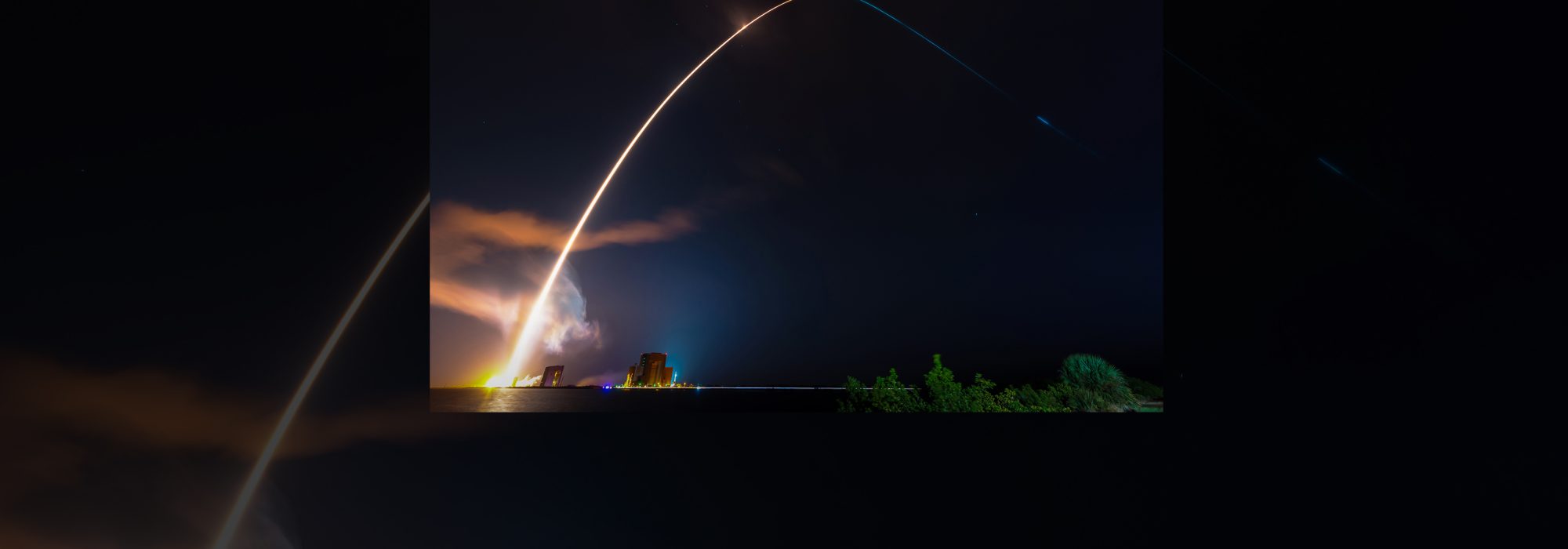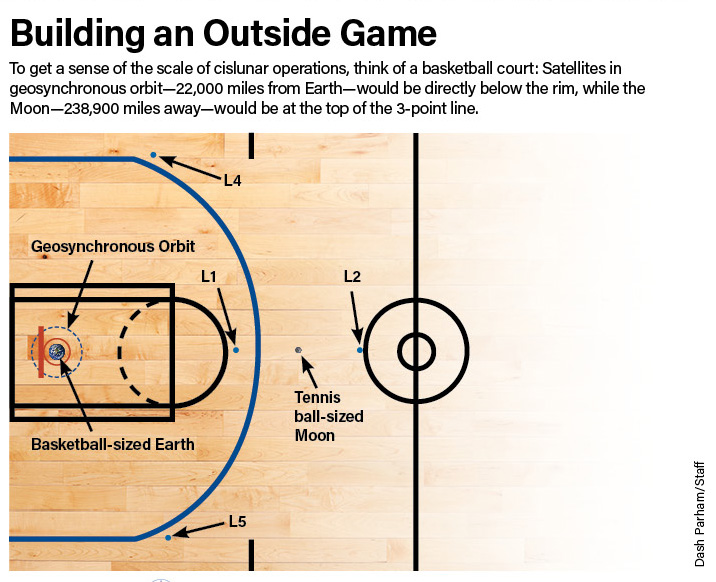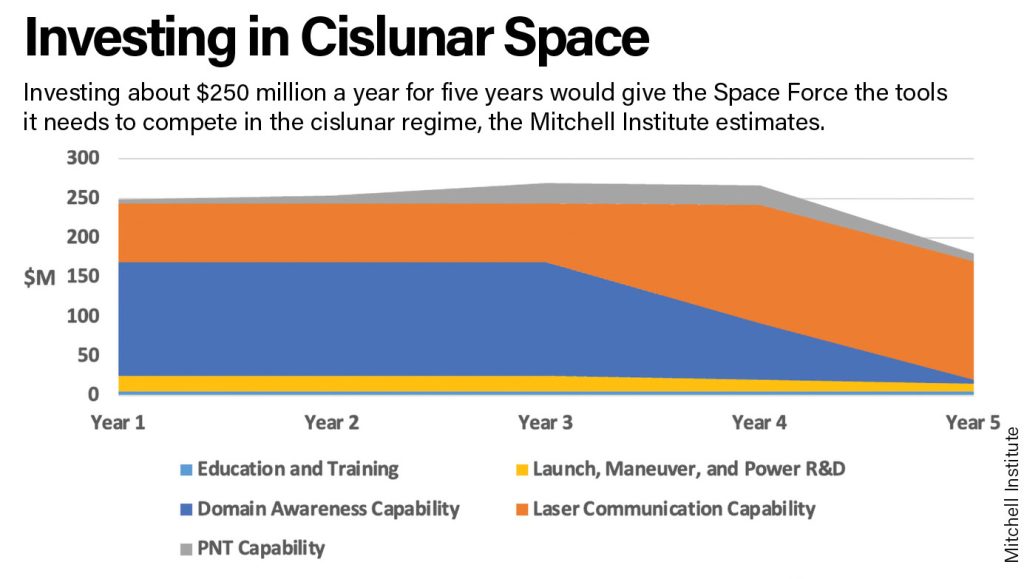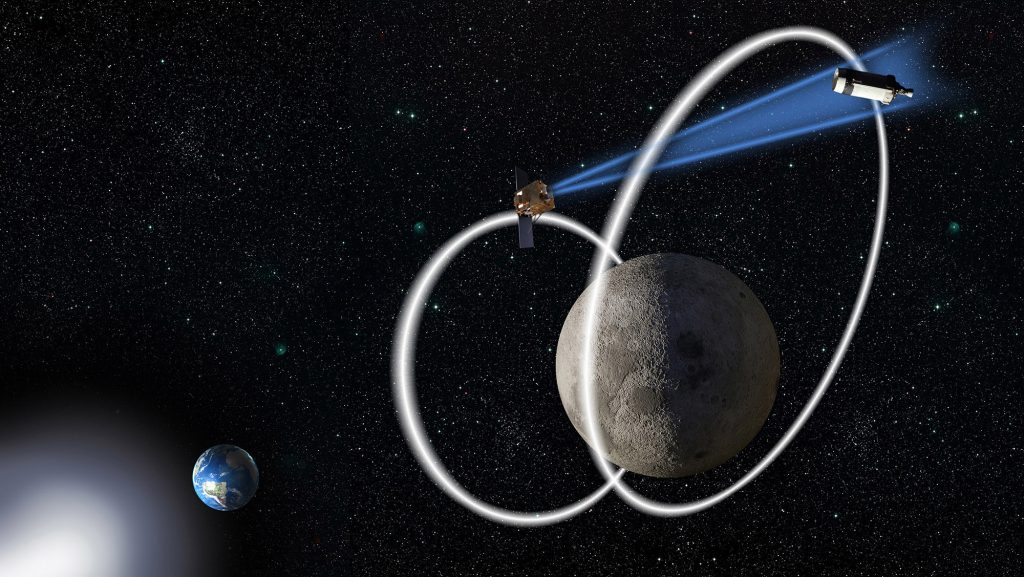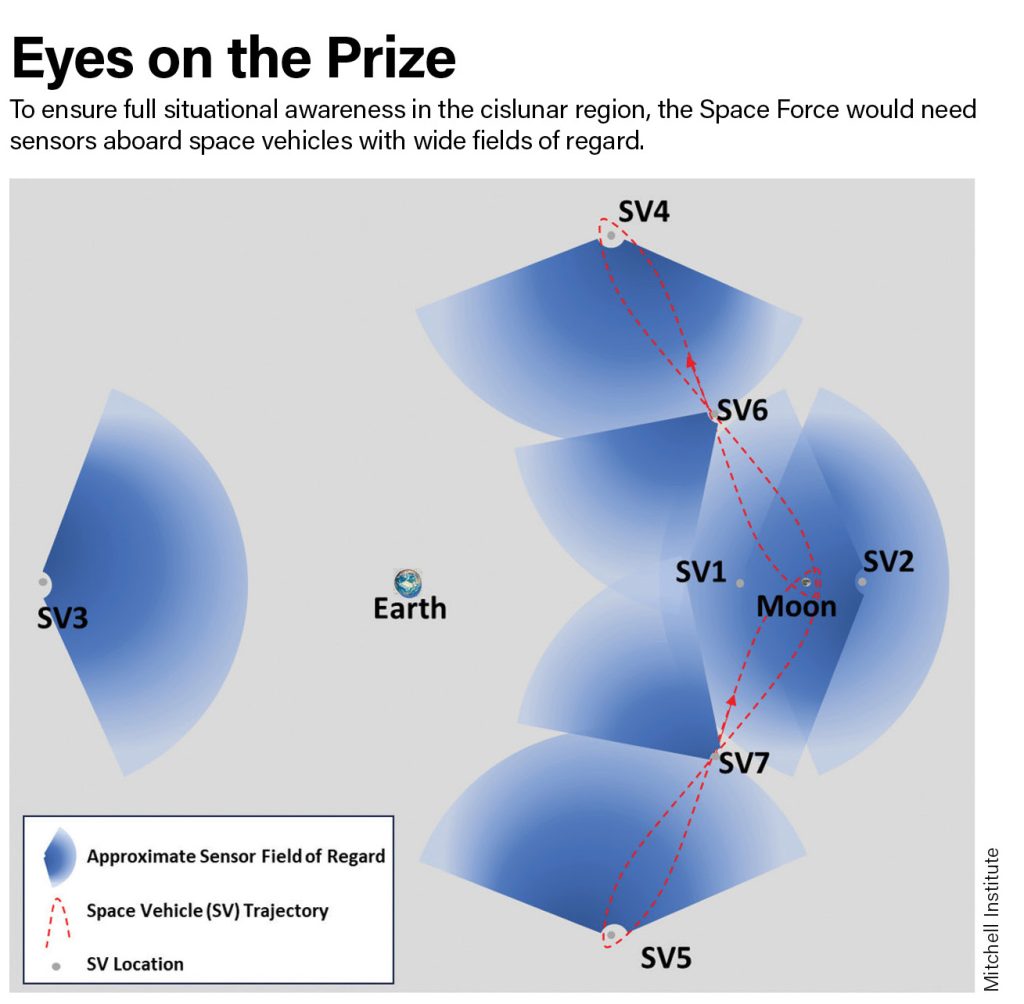Think of the Moon as the First Island Chain Off the Coast of Earth.
Global powers and new space entrants are racing to the Moon and the cislunar regime, an area extending beyond geosynchronous orbit out to more than 275,000 miles. In this region of space, spacecraft trajectories are influenced by the gravitational pull of both the Earth and Moon. There, few established norms exist to govern the multinational players and their scientific, economic, and geopolitical objectives.
Several countries are planning robotic missions, and some are pursuing a permanent human presence on the Moon. All told as of this writing, some 106 missions are planned for cislunar space this decade, representing the efforts of 19 countries and the European Space Agency.
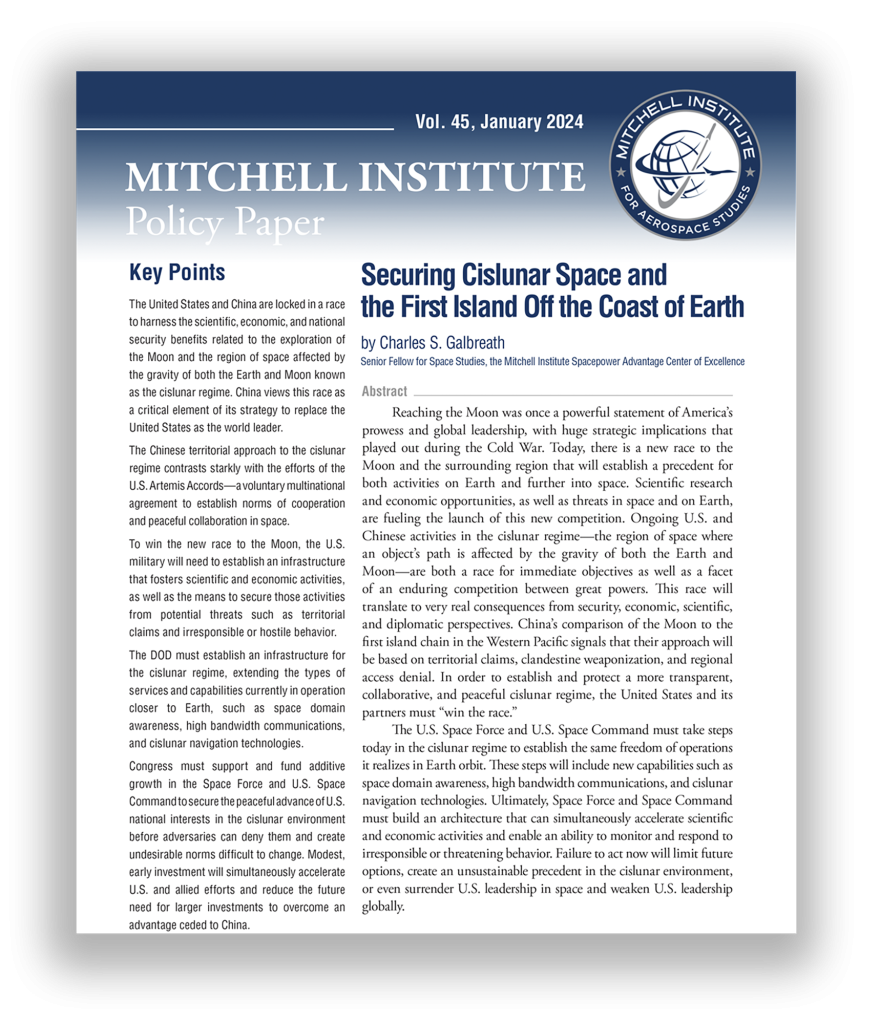
Col. Charles S. Galbreath, USSF (Ret.), Senior Resident Fellow for Space Studies, Mitchell Institute for Aerospace Studies.
Download the entire report at
Unlike the race to the Moon between the United States and the Soviet Union in the 1960s, this new space race involves dozens of countries, dynamic geopolitical tensions, and technical capabilities associated with sustained presence. That added complexity increases the urgency to view this regime in a new light: The U.S. Space Force and U.S. Space Command must begin taking steps today to ensure free and open access to cislunar space—or risk ceding the region to others who move more quickly.
Already in 2024, we’ve seen three missions head to the Moon. Japan’s Smart Lander for Investigating the Moon (SLIM) saw the nation became the fifth nation to land on the lunar surface, though it suffered a power issue after landing. The U.S. commercial effort Peregrine, the country’s first lunar landing attempt in decades, suffered a propellant leak once in space and burned up as it reentered the Earth’s atmosphere. Finally, Intuitive Machines reached the lunar surface, marking the first successful commercial mission to the Moon and the return of the United States to the Moon’s surface after over 50 years. All of these efforts encountered problems, underscoring the complexity and challenges of this new space race.
Even with the diverse set of nations heading to the Moon, there are now two main teams involved in the current race. On one side is the United States and an extensive group of aligned nations who have signed the Artemis Accords. This agreement reaffirms the peaceful intentions of space exploration and contains provisions on transparency, interoperability, emergency assistance, registration of objects, sharing scientific data, preservation of space heritage, extraction and use of space resources, deconfliction of activities, and debris mitigation. Many of these aligned countries enjoy advanced space programs, like Japan and India. They are joined by non-space-faring nations that support the peaceful and transparent approach outlined in the accords.
On the other side of this equation, China and Russia have partnered in the International Lunar Research Station (ILRS), along with Venezuela, Iran, the United Arab Emirates (UAE), and the nations of the Asia-Pacific Space Cooperations Organization (APSCO). Plans call for the ILRS to consist of a facility near the South Pole of the lunar surface and a station in cislunar space used to aid communication and transportation to the lunar facility.
In this race, either the United States and its partners arrive first and establish customary practices of safe and responsible collaboration, or they risk relinquishing key interests and governing principles to China and Russia. Given the lack of established international norms, this will be just like any other era of territorial exploration and expansion—those who arrive first set the terms. China’s ambition to supplant the United States as the world leader means it sees this race as an opportunity to shift the global balance of power. So, losing this race could seriously disadvantage the U.S. in the future.
Understanding the Cislunar Regime
Cislunar space is an incredibly dynamic region influenced by numerous forces and having caustic conditions. Mastering it demands collaboration from civil, commercial, and national security entities.
Unlike operations in Earth orbit, which are predictable and follow stable paths due to the Earth’s powerful gravitational force, spaceflight dynamics change dramatically as objects move beyond geosynchronous orbit and begin to come under the gravitational pull of the Moon. These competing forces greatly complicate spacecraft trajectories.
In the cislunar regime, there are five special locations where the gravitational pull of the Earth and the Moon balance and an equilibrium is attained. Known as Lagrange points, their gravitational equilibrium enables spacecraft to remain near the points and transit between them while using only minimal fuel. Their positions relative to the Earth and Moon also offer a commanding vantage of the cislunar regime, making them highly valuable to future domain awareness, communication, navigation, and scientific activities.
Another important aspect of the cislunar regime is its massive size. The average distance from the Earth to the Moon is 238,900 miles. To put in perspective, if the Earth were the size of a basketball placed directly under one hoop, the Moon would be the size of a tennis ball placed at the top of the 3-point line. In this comparison, the L4 and L5 Lagrange points would be just beyond the 3-point line roughly in line with the free-throw line. By contrast, the geocentric regime—where most satellites operate today—would be a small territory just beyond the rim.
That’s why maintaining domain awareness in the cislunar regime will be so difficult. It’s just a matter of sheer volume. That far from Earth, ground-based radars are far less useful; indeed, most existing space surveillance radars are useless for monitoring cislunar space. An entirely new architecture built from new technologies and models is needed to depict motion in this region to achieve situational awareness. These observations are essential to establishing and enforcing norms and standards.
The Moon poses its own unique challenges. With no appreciable atmosphere, there is nothing to block or absorb radiation. Earth’s atmosphere and magnetic field protect us and our equipment from solar and cosmic radiation. On the Moon, no such protective barrier exists, so personnel and equipment must be shielded. A second lunar hazard is regolith—lunar dust—formed from billions of years of meteor impacts and interaction with charged plasma from the Sun. Unworn by atmospheric or water erosion, regolith is fine, jagged, electrostatically charged silica particles covering the entire surface of the Moon. These particles caused electrical, mechanical, and even respiratory issues during the Apollo program. Future Moon missions could spread regolith hundreds of miles across the lunar surface, contaminating scientific instruments and experiments—or even causing damage to economic or historic sites, such as the Apollo landing locations. A third lunar challenge is the Moon’s extreme temperature ranges. Moving from a two-week lunar day to a two-week lunar night can see temperatures vary from 250 degrees Fahrenheit to minus 208 degrees Fahrenheit. Such an extreme range can leave materials brittle, and slash equipment life expectancy.
China’s Approach
China’s view of the Moon was made clear nearly a decade ago by Ye Peijian, then the lead for the Chinese Lunar Exploration Program. “The universe is an ocean, the Moon is the Diaoyu Islands, Mars is Huangyan Island,” he said in 2015, referring to disputed islands in the Western Pacific. “If we don’t go there now even though we’re capable of doing so, then we will be blamed by our descendants. If others go there, then they will take over, and you won’t be able to go even if you want to. This is reason enough.”
Expert analysis of PLA programs and doctrine makes clear that China seeks to be the preeminent global power in space. Overtaking the United States and “establishing a commanding position in cislunar space” is a vital step toward that objective. And while China claims the United States misrepresents its peaceful objectives in space, Peijian’s comparison of the Moon to the disputed islands in the Western Pacific heralds a confrontational intent. China’s aggressive actions in the Pacific can be seen as laying bare its ambitions in cislunar space, as China views national power in terms of territorial control. China has repeatedly signed bilateral agreements regarding disputed territories in the Western Pacific, only to break those agreements in an effort to control more territory. The fact that the PLA also controls China’s space program suggests that pattern will continue in space.
Consider how that might play out in a research scenario: If China were to establish a “scientific” station on the moon in an area rich in lunar ice, it might then require a keep-out zone to prevent others from interfering with their scientific research. Such a zone, however, could effectively commandeer the entire region and the resources in it, while denying access to other nations. Note that China is the only country to land on the far side of the Moon, and it intends a sample return mission from there in 2024. Importantly, using the gravity of the Moon, China could also conduct offensive operations against U.S. and partner space capabilities in the Earth orbit from an unobservable vantage point.
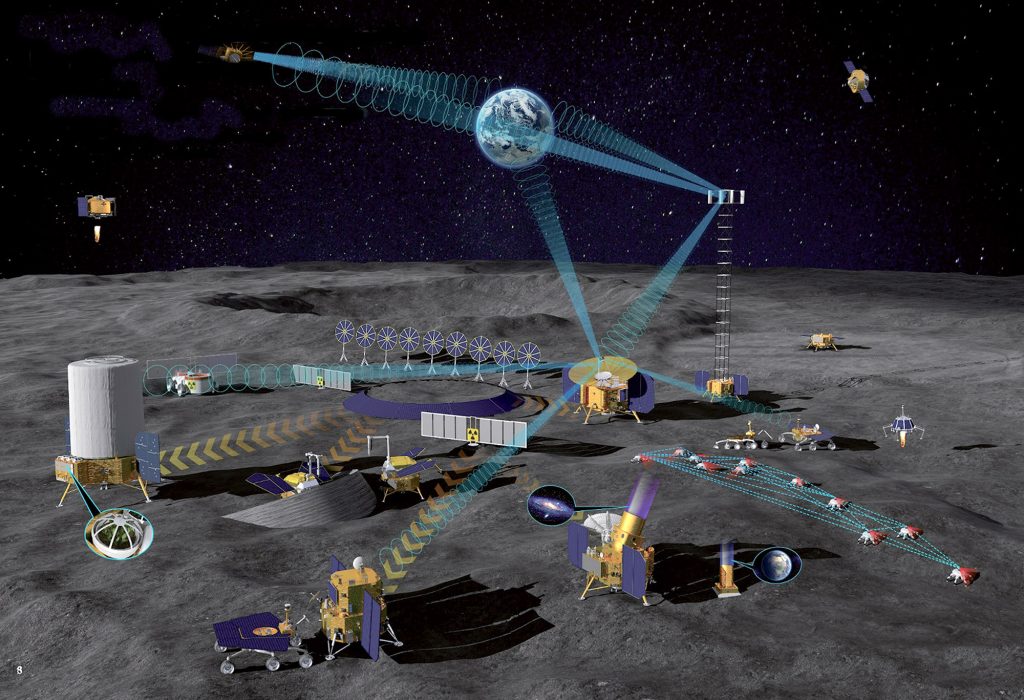
The Military in Cislunar Space
Cislunar activities are a new mission for the Space Force and Space Command and requires growth in funding and personnel. An initial budget of about $250 million annually for five years would be sufficient to establish the cislunar infrastructure critical to the race to the Moon, accelerating delivery of needed capabilities with the sufficient scale and effectiveness to support civil and commercial activities. It will also establish the necessary military means to secure those activities.
DOD must develop a cislunar strategy to define the military’s role and relationship to civil and commercial objectives in the cislunar regime. A DOD cislunar strategy would also define the military’s primary objectives as promoting a safe and stable environment, with the secondary benefits to enable or accelerate civil and commercial cislunar space development. DOD should also detail specific military objectives, such as assuring safe operations at Lagrange points or unfettered access to the lunar surface. This strategy would inform Congress in its resourcing, guidance, and oversight roles and encourage industry to invest.
The Space Force would build on that strategy, developing the skills and understanding to properly resource cislunar missions, beginning with the math, science, and expertise required. All Guardians would benefit from some familiarization with “cislunar basics,” but a small cadre must specialize in cislunar operations. This calls for about 200 cislunar-focused Guardians, to be added and developed over the next five years, and to facilitate the rapid transition of new capabilities from research to operations. They would be divided into four roughly equal lines of effort: supporting ongoing R&D efforts, acquiring and fielding capabilities, conducting operations, and training and staff assignments.
DOD must also develop new doctrine, concepts of operations (CONOPS), and requirements. Like the DOD cislunar strategy, new and/or updated doctrine, CONOPS, and requirements should include direct support to civil and commercial activities along with unique military requirements. Additionally, new requirements for navigation, maneuverability, and communication data rates will also be necessary to establish the needed cislunar infrastructure. CONOPS for achieving domain awareness or the exchange of information among military, civil, and commercial entities will advance transparency and cooperation. Within this scope of doctrine, CONOPS, and requirements, U.S. Space Command can identify how they will attribute potentially harmful or threatening behavior to promote stability and preserve interests.
To date, the Defense Advanced Research Projects Agency and the Air Force Research Laboratory have made the most notable DOD investments in this area. Early USSF participation in these efforts, and additional attention from the USSF in key areas will increase the probability of successful transition to operational capabilities.
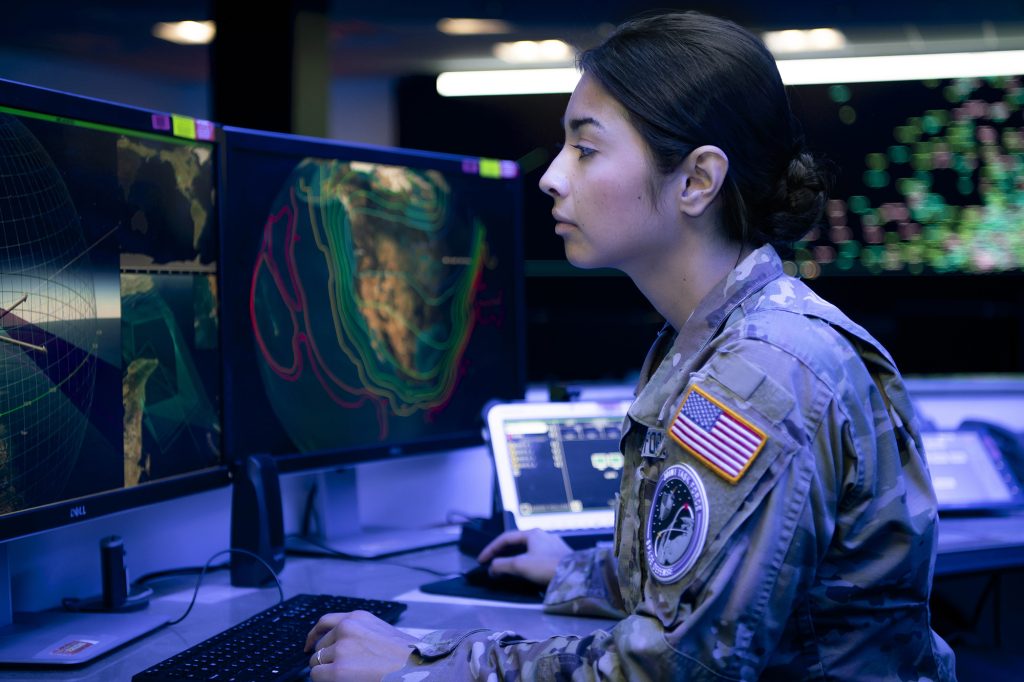
Domain Awareness
AFRL’s Oracle program will be vital to monitoring the vast cislunar regime and key areas of interest such as Lagrange points and transfer orbits. Unfortunately, due to its complexity and funding challenges, AFRL recently announced a delay in the Oracle program from a 2025 to a 2027 launch, reducing domain awareness for some 100 missions to the Moon planned in the next seven years and delaying the establishment of a robust domain awareness infrastructure for the coming decades. This delay drives risk at a time when adversary actions in this realm call for enhanced situational awareness.
High-Speed Communication
Assured, high bandwidth communication is another major infrastructure challenge DOD should tackle. Existing communication networks struggle to support the current mission load and will not be able to support the increased capacity required for the Artemis Accord’s purposes. Laser communication seems an ideal choice because it can be used for high-capacity data transfers. But this won’t be easy. The vast distances of the cislunar regime will require precise pointing accuracy to establish the links. The new network must also overcome challenges related to the relative positions and orientations of the Earth, Moon, and Sun, which will create eclipse periods and solar exclusions that necessitate multiple paths to assure uninterrupted communication. A series of relay satellites at Lagrange points, in lunar orbit, and in geosynchronous orbit will likely be necessary to meet the expected demand. A clear example of the viability of this approach is the recent achievement of a successful test message across nearly 10 million miles by the Deep Space Optical Communications (DSOC) payload aboard the NASA Psyche spacecraft.
Position, Navigation, and Timing
Assured position, navigation, and timing (PNT) for the cislunar regime is another area requiring R&D and the establishment of standards. Leveraging its experience with GPS, the USSF is in an ideal position to lead and shape this area. Ongoing commercial, civil, and international efforts would benefit from the unifying voice of the USSF to establish a cislunar PNT standard. This will require reviewing existing and proposed methods as well as additional research to ensure operational requirements and interoperability among Artemis Accord partner nations meet actual needs.
Propulsion and Maneuverability
Given the longer travel distances and challenges required to lift spacecraft higher out of Earth’s gravity well into the cislunar regime, it will be necessary to field vehicles with considerable propulsion and maneuverability. Like the Navy’s transition to nuclear powered submarines and aircraft carriers, nuclear propulsion will likely be a critical enabler to empower future USSF cislunar operations. DARPA’s DRACO is a good example of research into nuclear propulsion for cislunar. Because of the criticality of both rapid and efficient maneuver, an additional research effort into nuclear propulsion may be necessary to assure the delivery of viable nuclear propulsion options for future decision-makers. This will also reduce the risk of being tied to a single vendor or supply chain.
Power Generation and Distribution
Power generation and distribution will be another critical enabler for future cislunar activities. The ability to provide uninterrupted power to scientific, economic, or life-sustaining equipment will be indispensable. Options from solar to nuclear power are worth exploring. AFRL’s Joint Emergent Technology Supplying On-orbit Nuclear Power (JETSON) is a good example of an effort exploring alternative spacecraft power generation. The DOD must also consider other novel forms of power distribution. For example, the concept of beaming power to remote users will be instrumental in supporting a variety of cislunar missions. This could come from a solar- or nuclear-powered spacecraft that could beam power to a rover operating in the two-week lunar night or from a lunar surface station to a spacecraft in orbit around the Moon.
Lunar Surface Launch and Landing
Finally, USSF and other DOD entities will need to deliver equipment, supplies, and astronauts to the lunar surface while limiting the spread of harmful regolith. Realizing these goals requires new and responsible methods to land on and launch from the Moon. One potential option is the creation of launch and landing pads such that rocket thrust is not directed at loose surface rock and dust. Another possibility could employ a tether from the lunar surface as an elevator to move payloads down to and up from the Moon. A third option, specific to launch, could be an electromagnetic rail system. Similar systems are already in use today on aircraft carriers and roller coasters. On the Moon, a system could propel a payload to a predetermined altitude off the lunar surface so that once rocket motors or attitude thrusters engage, they will not dislodge regolith.
Field Operational Capabilities
As technologies mature in the areas previously described, the USSF must rapidly transition to the acquisition and fielding of operational capabilities to present to U.S. Space Command for employment and synchronization with civil and commercial efforts. It will be important for the government and industry to maintain the expertise and talent generated during R&D efforts to streamline the transition and prevent harmful delays due to workforce loss. Early decisions on architecture and steady, consistent funding are required to realize this vision.
Consider that Oracle or an Oracle-like system is intended to be a main element of the overall cislunar domain awareness architecture; it will likely require seven vehicles—one at each of the five Lagrange points and two transiting between L4 and L5 locations and the Moon. Deciding quickly and building it into the USSF planning, programming, and budgeting process early will increase the likelihood of fielding the capability before it is too late to support upcoming civil and commercial missions.
Conclusion
The window to make meaningful contributions in the race to the Moon and cislunar region is closing rapidly. It is time to act now. This involves Congress, the Space Force, Space Command, international partners, and civil actors seeking to operate in space. The prospects of ceding the advantage to an authoritarian and territorially minded Chinese and Russian program would create an even greater disadvantage—one increasingly difficult for the United States to overcome.
Early additive investment by Congress to the Space Force will enable the development of capabilities, which will accelerate the civil and commercial use of the cislunar regime and enable the establishment of the desired norms of cooperation, transparency, and responsible behavior for the Moon, cislunar regime, and beyond.
